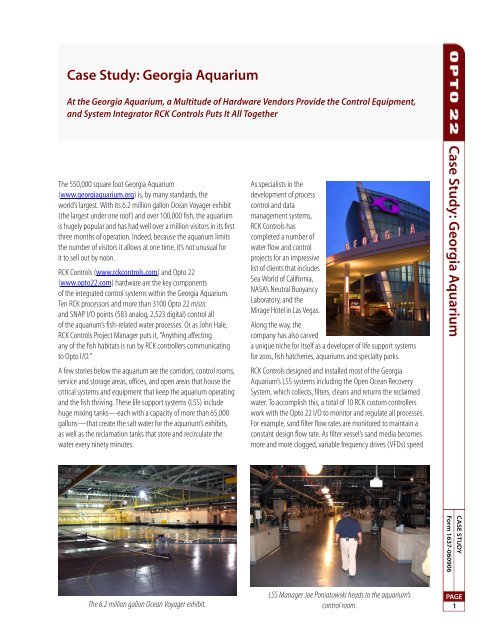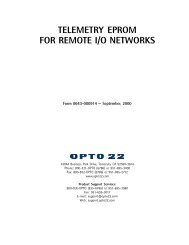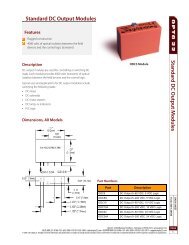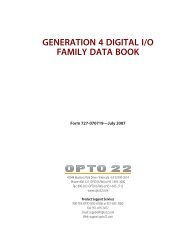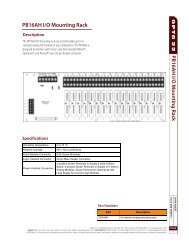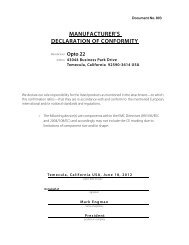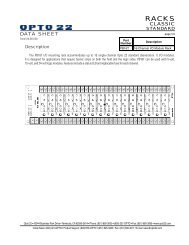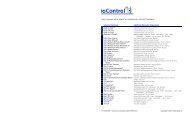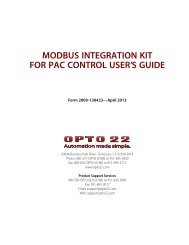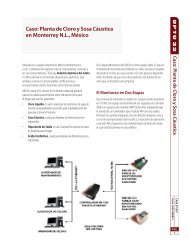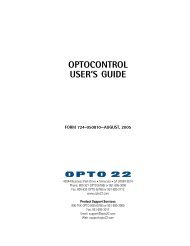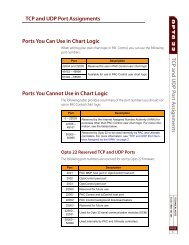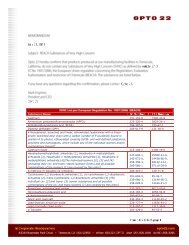1637 Case Study Georgia Aquarium - Opto 22
1637 Case Study Georgia Aquarium - Opto 22
1637 Case Study Georgia Aquarium - Opto 22
Create successful ePaper yourself
Turn your PDF publications into a flip-book with our unique Google optimized e-Paper software.
<strong>Case</strong> <strong>Study</strong>: <strong>Georgia</strong> <strong>Aquarium</strong><br />
At the <strong>Georgia</strong> <strong>Aquarium</strong>, a Multitude of Hardware Vendors Provide the Control Equipment,<br />
and System Integrator RCK Controls Puts It All Together<br />
The 550,000 square foot <strong>Georgia</strong> <strong>Aquarium</strong><br />
(www.georgiaquarium.org) is, by many standards, the<br />
world’s largest. With its 6.2 million gallon Ocean Voyager exhibit<br />
(the largest under one roof) and over 100,000 fish, the aquarium<br />
is hugely popular and has had well over a million visitors in its first<br />
three months of operation. Indeed, because the aquarium limits<br />
the number of visitors it allows at one time, it’s not unusual for<br />
it to sell out by noon.<br />
RCK Controls (www.rckcontrols.com) and <strong>Opto</strong> <strong>22</strong><br />
(www.opto<strong>22</strong>.com) hardware are the key components<br />
of the integrated control systems within the <strong>Georgia</strong> <strong>Aquarium</strong>.<br />
Ten RCK processors and more than 3100 <strong>Opto</strong> <strong>22</strong> mistic<br />
and SNAP I/O points (583 analog, 2,523 digital) control all<br />
of the aquarium’s fish-related water processes. Or as John Hale,<br />
RCK Controls Project Manager puts it, “Anything affecting<br />
any of the fish habitats is run by RCK controllers communicating<br />
to <strong>Opto</strong> I/O.”<br />
A few stories below the aquarium are the corridors, control rooms,<br />
service and storage areas, offices, and open areas that house the<br />
critical systems and equipment that keep the aquarium operating<br />
and the fish thriving. These life support systems (LSS) include<br />
huge mixing tanks—each with a capacity of more than 65,000<br />
gallons—that create the salt water for the aquarium’s exhibits,<br />
as well as the reclamation tanks that store and recirculate the<br />
water every ninety minutes.<br />
As specialists in the<br />
development of process<br />
control and data<br />
management systems,<br />
RCK Controls has<br />
completed a number of<br />
water flow and control<br />
projects for an impressive<br />
list of clients that includes<br />
Sea World of California,<br />
NASA’s Neutral Buoyancy<br />
Laboratory, and the<br />
Mirage Hotel in Las Vegas.<br />
Along the way, the<br />
company has also carved<br />
a unique niche for itself as a developer of life support systems<br />
for zoos, fish hatcheries, aquariums and specialty parks.<br />
RCK Controls designed and installed most of the <strong>Georgia</strong><br />
<strong>Aquarium</strong>’s LSS systems including the Open Ocean Recovery<br />
System, which collects, filters, cleans and returns the reclaimed<br />
water. To accomplish this, a total of 10 RCK custom controllers<br />
work with the <strong>Opto</strong> <strong>22</strong> I/O to monitor and regulate all processes.<br />
For example, sand filter flow rates are monitored to maintain a<br />
constant design flow rate. As filter vessel’s sand media becomes<br />
more and more clogged, variable frequency drives (VFDs) speed<br />
<strong>Case</strong> <strong>Study</strong>: <strong>Georgia</strong> <strong>Aquarium</strong><br />
CASE STUDY<br />
Form <strong>1637</strong>-060906<br />
The 6.2 million gallon Ocean Voyager exhibit.<br />
LSS Manager Joe Poniatowski heads to the aquarium’s<br />
control room.<br />
PAGE<br />
1
<strong>Case</strong> <strong>Study</strong>: <strong>Georgia</strong> <strong>Aquarium</strong><br />
is controlled. “The recovery system we designed required<br />
us to connect and monitor a number of I/O points,” says Hale.<br />
“Valve positioning, analog reclamation water levels and flowmeter<br />
readings all help determine when a sand filter can be automatically<br />
backwashed. When a VFD’s speed is ‘maxed out’ and filter<br />
performance has declined, it means the filter is ready for<br />
backwashing and the process is initiated.”<br />
“There are 56 filters just for the main tank,” adds Joe Poniatowski,<br />
the <strong>Georgia</strong> <strong>Aquarium</strong>’s Life Support Systems (LSS) Manager.<br />
“Monitoring and maintaining those alone would be a full-time<br />
job. Automating this process frees LSS from this responsibility.”<br />
“All fish water backwashes to a common reclamation system,”<br />
says Poniatowski. “We process and reuse almost all of this water,<br />
resulting in a close to zero percent salt water discharge. That’s<br />
something that’s pretty much unmatched by most other aquariums.”<br />
For the <strong>Georgia</strong> <strong>Aquarium</strong> to transport, process and reuse its water<br />
requires a host of water treatment equipment, hundreds of pumps,<br />
and over 61 miles of piping. Water is carried from the salt water mixing<br />
tanks to the exhibits and then back to the reclamation tanks. Along the<br />
way, the water is treated through the use of carbon filters (which strip<br />
out chlorine and fluoride) and protein skimmers, large tanks used to<br />
collect the water and remove any dissolved organic compounds (DOC)<br />
through a process called fractionation. Fractionation occurs when<br />
massive amounts of tiny air bubbles are injected into the water by<br />
a high pressure water pump and air valve. The rising air bubbles act<br />
as a lift, allowing DOC particles to attach to the bubbles and hitch a<br />
ride to the top of the protein skimmer, where they are captured in a<br />
collection cup and rinsed away via a jet spray.<br />
Water reclamation tanks<br />
Protein skimmers<br />
Dissolved organic compounds are collected at the tip of the<br />
protein skimmers and disposed of.<br />
PAGE<br />
2
<strong>Case</strong> <strong>Study</strong>: <strong>Georgia</strong> <strong>Aquarium</strong><br />
The <strong>Georgia</strong> <strong>Aquarium</strong> has 59 of these protein skimmers and each<br />
is equipped with its own on-board I/O. A mix of analog and digital<br />
connections to injector pumps, spray down valves, and pH and ORP<br />
(oxygen reduction potential) sensors and other components on this<br />
equipment, effectively enable each of the individual protein skimming<br />
processes plus a lot more.<br />
“Some of the species here are very sensitive to water temperature,<br />
salinity, pH balance, turbidity, etc.,” says Poniatowski. “So we need<br />
to have very precise control over all of our protein skimmers and other<br />
water treatment systems. The RCK control engine provides just<br />
that.”The aquarium’s LSS control room serves as a center of operations<br />
where Poniatowski and his staff can view all of the aquarium’s 62<br />
I/O panels (and thus any and all of the aquarium’s critical life support<br />
systems) from their computers.<br />
“What makes this possible is our use of standard Ethernet-enabled<br />
components in the design of the control system,” says Hale. “The RCK<br />
controllers communicate over the aquarium’s dedicated and secure<br />
Ethernet network, allowing full monitoring capabilities from any<br />
connected PC or laptop.”<br />
In such cases, a graphical user interface, designed by RCK Controls,<br />
gives a straightforward presentation of all of the processes taking<br />
place with the protein skimmers, mixing tanks, pumps and other<br />
equipment. Wireless connectivity enables mobile LSS staff carrying<br />
handheld units to receive alarm data instantly should any of these<br />
aquarium systems need servicing.<br />
At the <strong>Georgia</strong> <strong>Aquarium</strong>, hardware from RCK Controls and <strong>Opto</strong> <strong>22</strong><br />
controls and monitors all of the exhibits’ critical life support system<br />
equipment and components including:<br />
• Flow monitors (GF Signet)<br />
• Heat exchangers<br />
• Ozone equipment (WEDECO)<br />
• Injector pumps<br />
• Sand Filters (Neptune Benson)<br />
• Filter pumps (USFilter, a Siemens company)<br />
• Draindown pumps<br />
• Protein skimmers (RK2 Systems)<br />
• Salt water mixing tanks (Neptune Benson)<br />
• Salt water reclamation tanks<br />
• Discharge, inlet & backwash valves (ASAHI & Bray)<br />
<strong>Opto</strong> <strong>22</strong> I/O in a <strong>Georgia</strong> <strong>Aquarium</strong> control panel.<br />
A Linksys router provides wireless connectivity.<br />
Whale shark<br />
PAGE<br />
3
<strong>Case</strong> <strong>Study</strong>: <strong>Georgia</strong> <strong>Aquarium</strong><br />
<strong>Georgia</strong> <strong>Aquarium</strong> Fast Facts:<br />
• The aquarium has its own animal hospital where doctors and surgeons<br />
anesthetize, treat, and operate on sick or injured fish.<br />
• More than 90% of the aquarium’s fish come from agriculture, that is,<br />
they were originally caught or raised for food.<br />
• It took thirty-six hours to fill the aquarium’s 6.2 million gallon<br />
Ocean Voyager exhibit.<br />
• Ralph and Norton, two whale sharks, are the aquarium’s largest animals<br />
and a visitor favorite.<br />
• To obtain the correct mix of major, minor, and trace elements for the Ocean<br />
Voyager exhibit, 741 tons of Instant Ocean® sea salt were added to the water.<br />
• The facility is equipped with a 9000 lb. freight elevator that opens onto a<br />
loading dock so trucks can make easy deliveries. Many of the aquarium’s<br />
larger species arrived this way.<br />
RCK Controls designed these custom HMI screens to provide an<br />
easy-to-understand control interface for LSS personnel.<br />
RCK Controls, Inc. (www.rckcontrols.com) specializes in<br />
the development of process control and management<br />
systems. This includes the design, development, construction,<br />
operation, and management of cogeneration projects and<br />
energy and environmental resource management solutions<br />
for zoos, fish hatcheries, aquariums and specialty parks.<br />
RCK Controls also develops major life support systems for<br />
marine animals. The company integrates <strong>Opto</strong> <strong>22</strong> hardware<br />
with process control and data management software for<br />
applications related to water flow and water quality control.<br />
Completed projects include Sea World of California’s Journey<br />
to Atlantis, Sea World of Florida’s Discovery Cove, NASA’s<br />
Neutral Buoyancy Laboratory and the Mirage Hotel’s<br />
Dolphin Habitat.<br />
PAGE<br />
4


